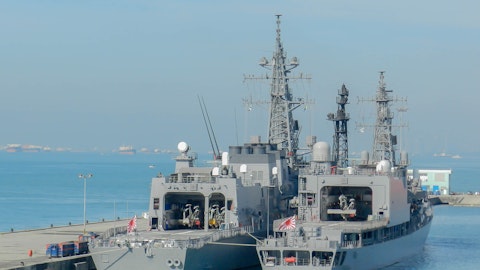Lynn Bamford: So the supply chain is, you know, and it’s interesting to talk to some of the team members, just to get their latest perspective on it earlier this week. And the supply chain is nowhere near at the point it was in 2019. And that really is, as you just kind of referenced, there’s no clear line of sight on when the supply chain would perform at that level again. It is largely stabilized. I’m very proud of how we have responded the teams that are right in the middle of this have responded and implemented new systems, new tools, new approaches to be successful with the supply chain the way it is in its current state. And so I think we are being successful, and it isn’t just that the supply chain is completely back to normal.
That’s how we responded as a business. And I mean, you can see that, where we hit the hardest was in defense electronics. And you can see that with the 12% to 14% growth we’re now projecting in that segment this year. But just a little color on it. Broadly, we think statistically of what’s going on in the supply chain, we look at a lot of different metrics across it. And what’s considered our long-league parts, which we consider anything over 40 weeks, there’s pretty much stability in the lead times and some improvement on the on-time delivery of those parts. But there’s still components that are out there at 52 weeks and some even greater of lead time. And there was nothing that was that long, 26 weeks would have been the longest we would have seen prior to the pandemic.
So, there’s still that. And I will say that recently within the lead times of components that are less than that 40 weeks, some under 20, some in the 20 to 40 kind of categories. We’ve seen some volatility in the lead times in those components and some of those going back up from how they had come down prior. So, it’s still a dynamic environment that the team is having to deal with. The areas where we see some of the lead times creeping back up, it’s really around some of the older legacy processors and memory components, example, that are brought to the market many, many years ago. That dynamic is true and our industrial businesses also is where they have largely seen their lead times come back from the 52 weeks down to 10 to 14, but they still have some issues with where they have legacy parts.
And part of our value proposition out of our defense electronics team is, with the combination of we bring state-of-the-art products to the market with the latest technologies across processors, GPUs, FPGAs, all the various ways you can do computing. But we also work with our customers to keep producing the same products that they build systems on for many, many years, 10 to 15, even up to 20 in some cases, years. And so, we have a lot – we’re very dependent on some of those legacy processors and are working very hard to do that. So, the team is managing it. I’m not foreshadowing any kind of change or problems going forward. I think we’ve got systems to manage it, but we’re still dealing with a situation that isn’t the way it used to be.
Chris Farkas: Yes, and I’ll just comment really quickly on margins there, Louie. I mean, I think as you look at 23 to 20, 23.5 to 23.7 on the margins, I mean, we’ve been here before. You can back up and see it in 2020 and 2019. A lot of what I had said earlier on the call regarding our forward outlook in 2024, it’s really going to depend on where those investment opportunities are in defense electronics. But we will manage as we have historically the entire portfolio to continue to provide that incremental margin expansion.
Louie DiPalma: That’s good. Thanks for all the detail. Greatly appreciated. And I guess one final one, it appears that IIJA infrastructure bill funding is hopefully set to increase next year. At least that’s what some of the companies have been saying on their third quarter earnings calls. Can you remind investors, do you have anything to think of exposure on your industrial side and even a little on your federal side as it relates to the IIJA?
Lynn Bamford: So we do, not directly, we’re not out building bridges and things, but we do have tentacles that a lot of funding is a good tailwind from Curtiss-Wright and whether that’s – we have a significant footprint across construction vehicles. And so as there is building of the various infrastructures that it’s directly funding, that’s driving increases in those areas that will come through to Curtiss-Wright with our content across those types of customers. Inside of that, the bills there are also investments for the civil nuclear fleet that is very much helping a lot of these plants, go from their 60 to 80-year life extensions. And Chris talked about what we’re seeing in our aftermarket sales, very, strong performance out of that team.



